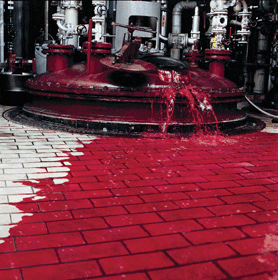The DBU: promoting sustainable chemistry
Maximilian
Hempel
Deutsche Bundesstiftung Umwelt, An der Bornau 2, 49090, Osnabrück, Germany. E-mail: m.hempel@dbu.de; Fax: +49(0)541 9633 193; Tel: +49(0)541 9633 310
First published on 26th October 2006
Abstract
The Deutsche Bundesstiftung Umwelt (DBU) is among the world's largest environmental foundations. Its actual fields of promotion and some of the results of its successfully completed projects are summarized.
Origin and function
In 1990, the Deutsche Bundesstiftung Umwelt DBU was established by decision of the German Bundestag with the objective of promoting innovative projects in the field of environmental protection. The promotional activities include the fields environmental technology, research and communication. As a non-profit organisation and foundation established according to Civil Law, the DBU's promotional activities are beyond state programmes but can supplement these. The DBU is among the world's largest environmental foundations (Fig. 1); since its establishment nearly 6000 projects have received financial backing totalling approximately €1.1 billion, with particular focus on small and medium-sized enterprises. | ||
| Fig. 1 Headquarters of the Deutsche Bundesstiftung Umwelt, Osnabrück, Germany. | ||
The Deutsche Bundesstiftung Umwelt promotes the sustainable model of development. At the United Nations conference in Rio, 179 countries committed themselves to this model by signing an agenda for the 21st century (http://www.bmu.de/files/pdfs/allgemein/application/pdf/agenda21.pdf). The concept of ‘sustainable development’ requires ongoing strategies,e.g. by:
• Minimising consumption rates of transitory resources via improvement of efficiency, substitution of transitory resources by renewable ones and by recycling (life cycle assessment).
• Preventing the consumption rates of renewable materials and energies from exceeding their given rate of reproduction.
• Preventing emissions from exceeding the capacity for regeneration and absorption by environmental media and human beings.
The DBU supports in two ways, by personal subsidy (postgraduate scholarship) and by subsidies for companies and institutes (co-operation projects).
Postgraduate—Scholarship at German universities
The Deutsche Bundesstiftung Umwelt has established a German scholarship programme to promote promising young scientists in the field of environmental protection. Per annum about 60 scholarships for postgraduates from different disciplines—mostly in chemistry, biology and engineering—are provided.Scholarship applications can be submitted twice a year, on the 15th February and the 15th August. Besides a brief and a detailed outline of the research project further documents such as recommendation letters are required. Corresponding forms are obtainable from the DBU office or http://www.dbu.de/stipendien/download.php (German version).
The application will be assessed by external experts. Afterwards the most promising candidates are invited to present their project in a selection procedure which is held in the DBU office twice a year. The committee consists of about 20 independent external and DBU scientists. Grants are approved shortly after the interviews.
With the Baltic states, the region of Kaliningrad, Poland, the Czech Republic, Hungary, Romania and Bulgaria, the DBU initiated an international scholarship programme, offering an additional qualification for young scientists from those countries through a research stay in Germany.
The partner organisations co-ordinate the application procedure in the respective countries. After the programme has been announced at the foreign universities, a selection of the best candidates for a 6–12 month research stay in Germany takes place once in a year (http://www.dbu.de/english/international.php).
Cooperation projects between institutions and small and medium enterprises (SME)
The DBU particularly encourages co-operation projects between small and medium-sized enterprises and research institutions. The three main criteria for obtaining a subsidy are:• Innovation: the project has to promise an advance compared to the state-of-the-art of current research and technology.
• Exemplary and model character: the innovation should be of interest to a broad segment of the actors (e.g. a complete industrial sector). It should also be possible to implement the innovation under commercial conditions within a brief time-scale.
• Environmental benefit: the innovation should lead to new, supplementary measures for the protection of the environment.
The actual fields of promotions are laid down in the guidelines with nine special topics. One field of support is Sustainable Chemistry—procedures and products, aiming to promote projects within the following objectives:
• Development of chemical techniques to convert renewable and waste materials to new products and materials.
• Development of new applications of micro- and nano-techniques (e.g. micro-reaction for synthesis).
• Development of optimized chemical processes, e.g. with new catalysts or separation techniques.
Projects in this field usually include a life cycle assessment or eco-efficiency analysis. The decision to fund largely depends on the concrete contribution of the project towards environmental benefit. Within those projects, the Deutsche Bundesstiftung Umwelt supports additional measures for dissemination and consolidation project results.
Results of successfully completed projects
The following brief reviews of three successfully completed projects should give an impression of the variety of supported projects within the last three years in the field of sustainable chemistry.Deep desulfurisation of diesel by extraction with ionic liquids
The company Solvent Innovation GmbH in Cologne, the Chair for Chemical Engineering of the Bayreuth University and the Chair for Chemical Reaction Technology of the Erlangen-Nuremberg University jointly developed a new extraction procedure for the desulfurisation of diesel on the basis of ionic liquids.S compounds in fuels lead to SOX emissions, causing air pollution and acid rain. Thus, great effort is needed to reduce the S content in transportation fuels to 10 ppm and below. Halogen-free ionic liquids like 1-n-butyl-3-methylimmidazolium octylsulfate ([BMIM]OcSO4) are suitable to extract oil refinery streams by liquid–liquid extraction. This concept provides an interesting (supplemental) alternative for deep desulfurisation. The process enables a desulfurisation under moderate conditions—ambient temperature and pressure—without use of additional hydrogen. It can be considered, that especially those sulfur compounds, which are difficult to reduce by conventional hydrodesulfuration (HDS), e.g. dibenzothiophene derivates, are selectively extractable.
The project shows, that ionic solvents are capable to replace the conventional technologies for the desulfurisation of diesel. Compared with usual solvents, ionic liquids exhibit various ecological benefits, e.g. they do not evaporate, they are neither combustible nor do they contaminate the atmosphere.1,2
Micro-reaction technology in the chemical industry and its ecological potential
The characteristic feature of microreactors is their significantly higher specific surface as compared to conventional reactors. Thus, heat transfer coefficients are very high and allow an extremely efficient heat exchange. Microstructured reactors are therefore especially suited for highly exothermic reactions which can be conducted in a practically isothermic manner. High surface-to-volume ratios lead also to higher yields and improved selectivities during the formulationof chemical compounds. In co-operation with the Bayer AG the company CPC Cellular Process Chemistry Systems GmbH, Mainz developed a microreaction system for very exothermic lithium–organic reactions—the two-step synthesis of m-anisaldehyde from m-bromanisole. Due to the exothermic behavior of this reaction, the production of m-anisaldehyde requires significant safety measures.The Institute for Technical Chemistry and Environmental Chemistry of the Friedrich-Schiller-University Jena performed a life-cycle assessment (LCA) comparing the conventional discontinous batch process with the newly developed continous micro-scale set-up.
The life-cycle assessment clearly indicates positive environmental impact for the micro-reaction technology: the lower solvent demand, the reduced number of rinsing and cleaning steps, the drastically decreased amount of waste and energy consumption. Compared to these ecological benefits, the fabrication of the microreactors, thermostats, distillation units etc. only plays a minor role. The advantages include also safety features (Fig. 2): microreaction technology reduces the risk of storing and handling dangerous chemicals. The amount of reactants used is much smaller than that in conventional reactors.3–5
 | ||
| Fig. 2 One objective of sustainable chemistry is to prevent emissions. | ||
Sustainability in the organic chemistry lab course (Nachhaltigkeit im organisch-chemischen Praktikum)
This project aims to implement sustainability into the education of chemists. For a long time the most important goal of a chemist was to create a compound in suitable amounts and high purity from available starting materials. The traditional education in chemistry had a strong focus on practical lab techniques and methods for compound purification. In the past, ecological aspects, e.g. energy consumption or amount of waste and by-products, were only attached to industrial processes, not to education and laboratory experiments. Although the goal for a chemist, working in organic synthesis, is still the same: synthesizing a compound in good yield and high purity, additional skills must be acquired. In the last 20 years much more attention has been attributed to undesired effects of chemical compounds on the environment. Thus, we have learned one clear lesson: it is much better, less difficult and less expensive to develop processes and compounds which are sustainable from the beginning than to remove dangerous chemicals from the environment by end-of-pipe-techniques. To allow a better coverage of all the issues of sustainability in chemical education a team of seven German universities developed a database, which contains approx. 100 laboratory experiments. Besides a detailed experimental protocol, safety guidelines and analytical data, a variety of additional material is provided concerning the different fields of sustainability. The material can be individually adapted to any type of organic chemistry teaching lab course or used for projects in and outside the classroom. All materials are available free of charge at the following website: http://www.oc-praktikum.de/.6Acknowledgements
The author would like to thank Dr C. Schneider, Olympus Ireland, for humorous orthographical support.References
- J. Eßer, P. Wasserscheid and A. Jess, Green Chem., 2004, 6, 316–322 RSC.
- M. Uerdingen, P. Wasserscheid and A. Jess, Tiefentschwefelung von Dieslöl durch Flüssig-Flüssig-Extraktion mit ionischen Flüssigkeiten—Final Report of the DBU-funded Project AZ 21490, Solvent Innovation GmbH, Köln, 2006, 79 pp Search PubMed.
- T. Schwalbe, A. Kursawe and J. Sommer, Application Report on Operating Cellular Process Chemistry Plants in Fine Chemical and Contract Manufacturing Industries, Chem.-Ing.-Tech., 2005, 28, 408–419 CAS.
- D. Kralisch and G. Kreisel, Bewertung der ökologischen Potenziale der Mikroverfahrenstechnik, CIT, 2005, 77, 6, 2005, 784–791 Search PubMed.
- V. Autze and D. Kralisch, Mikroreaktionstechnik für umweltgerechtere Produktion in der chemischen Industrie—Final Report of the DBU-funded Project AZ 19348, Institut für Technische Chemie und Umweltchemie Friedrich-Schiller-Universität Jena, Jena, 2006, 40 pp Search PubMed.
- M. Bahadir, H. Hopf, A. Nijakowski, R. Vogt, B. Jastorff, R. Störmann, J. Ranke, B. Ondruschka, G. Kreisel, M. Nüchter, A. Diehlmann, D. Lenoir, H. Parlar, C. Wattenbach, J. Metzger, U. Biermann, B. König, Ch. Braig and B. Krelle, Neues und nachhaltigeres organisch-chemisches Praktikum, Verlag Harri Deutsch, Darmstadt, 2005, 150 pp Search PubMed.
| This journal is © The Royal Society of Chemistry 2007 |
